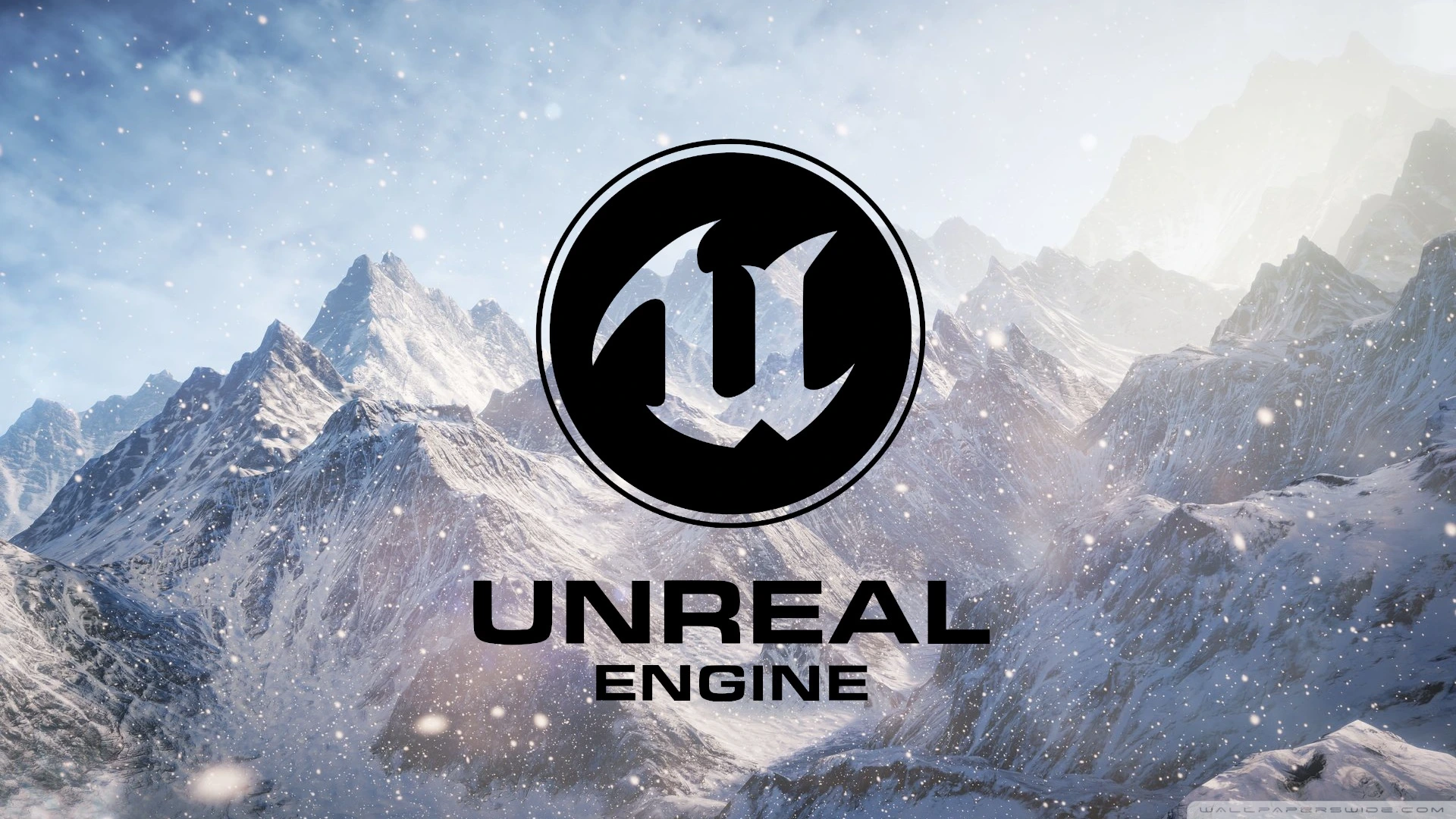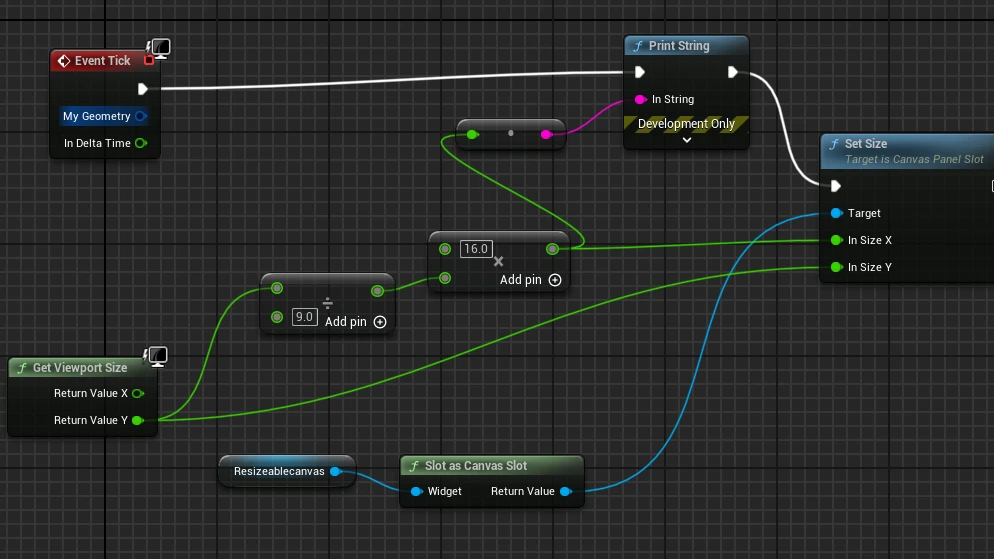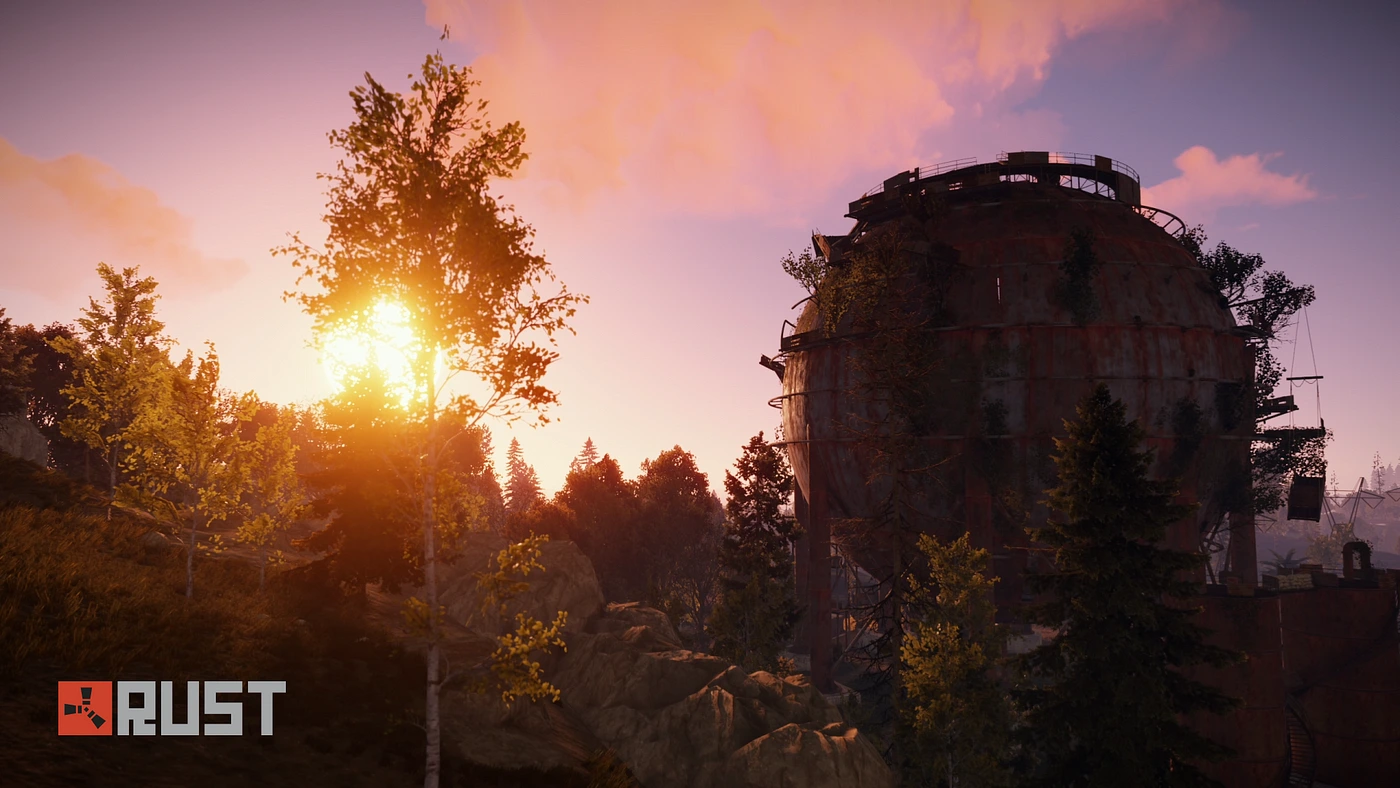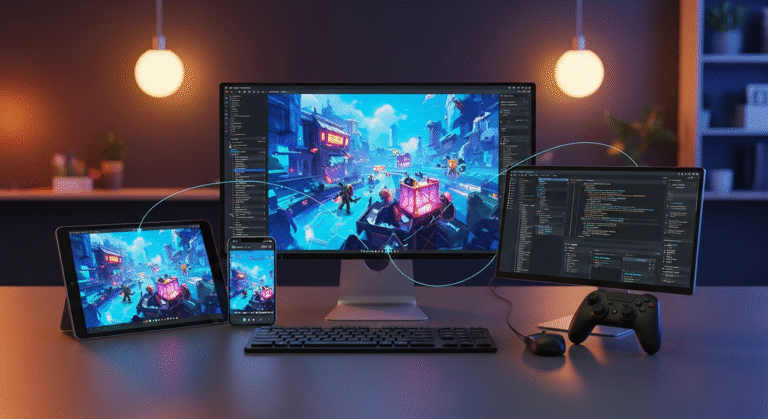There are two giants of the game development world: Unity and Unreal Engine. Both are incredibly powerful for game-making but with different quirks and difficulties. Unity and Unreal Engine are two of the most popular game development platforms, each with its own strengths and suited for different types of projects. Choosing between Unity and Unreal Engine depends on the specific needs of your project. Unity is great for beginners, mobile development, and 2D games, while Unreal Engine excels in high-end graphics, complex 3D projects, and VR experiences.
If you’re a newcomer interested in getting started, or a veteran dev comparing these engines for your next project – don’t miss this extensive examination of the industry’s top contenders.


Need Game Art Services?
Visit our Game Art Service page to see how we can help bring your ideas to life!
Unreal Engine

Since its inception in 1998, Epic Games’ Unreal Engine has been something of a cornerstone for AAA game development. Known for providing stunning visuals and a powerful toolset, Unreal Engine has been used to create some of the most beautiful games available on the market today. Releasing in 2022, Unreal Engine 5 raised the bar even higher with technologies like Nanite and Lumen, which resulted in a hyperrealistic rendering of graphics like never seen before.
The Unreal Engine is written in C++ and a little tougher for beginners, but also has great performance with low-level control. That said, the engine’s exposed Blueprint visual scripting system is a far more friendly onramp for non-programmers. Thanks to Unreal’s World Composition system, and suite of tools for terrains, the engine worked naturally and beautifully with making large open-world spaces such as these.
Unreal Engine also seems to be well placed as multiple creative fields converge, amid Epic Games’ aggressive efforts to make the engine not just a tool for games but one that can power future film sequences and television content with greater production values due in no small part due do more advanced architectural visualization than many have encountered ever before. This makes more room for the creation of state-of-the-art abilities that game developers can draw on to make games even closer to realism than ever before.
Unity Game Engine

Since it was released in 2005, Unity has been a favored tool for indie developers and mobile game creators. Unity is a flexible and powerful development platform for creating multiplatform 3D and 2D games. It is a perfect choice for beginners because of its intuitive interface and vast documentation, but it also stays at the forefront of larger studios by providing robust features that are capable of being extended.
A lot of developers prefer Unity because it uses C# as its primary scripting language, which is both easy and versatile to work with. It is perfect for small teams and experimental projects, supporting rapid prototyping workflow as a component-based engine. Unity itself has a huge, time-saving library of pre-made assets, tools, and plugins.
Although in the past Unity was under fire for its visuals not being as pretty compared to Unreal, lately new updates have drastically increased rendering quality. The future roadmap for Unity also promises continued improvements in graphics, performance, and workflow efficiency.
Game Development Difficulty and Complexity
Unity presents a little less steep learning curve and it’s much easier to learn as compared to UE. Unity has a reputation for being more developer-friendly, as generally there is less to learn upfront and plenty of tutorials online. An architecture based on components and the power of C# allows newcomers to get started easily by creating simple games soon.
Unreal Engine has a greater learning curve upfront, particularly for newcomers to C++ programming. That said, the introduction of Blueprint Visual Scripting made it a lot easier for non-programmers to get into using Unreal. While Unreal can feel extremely masterful and very powerful if you take the time to learn it, its editor is actually rich with features and options.
The engines both demand serious study but they are aimed to cater to different skills. Unity is far more flexible, which really lets you prototype and play with a wide diversity of games than Unreal having its extensive toolset suits it well for high-quality 3D game development out of the box.
In the end, the development will be as hard and complex based on your project scope and the expertise of your team. Where Unity is probably the right choice for smaller teams and newcomers, Unreal could be more worthwhile if you are working on a 3D project.
3D Graphics Rendering

Despite progress made in rendering for 3D graphics, the best tools available today remain Unity and Unreal Engine (which take different approaches).
Unreal Engine is a powerhouse when it comes to visual fidelity out of the box, especially for photorealistic rendering. This gap only widened with the release of Unreal Engine 5. From Nanite which enables the use of movie-quality photogrammetry assets in real-time, to Lumen – a fully dynamic global illumination solution for all lights and setups, Unreal Engine 5 really takes things up another notch. Together, these capabilities mean Unreal is a compelling platform for projects requiring maxed-out photorealism.
Historically, Unity has always fallen short in terms of out-of-the-box visual quality compared to Unreal – but it has come a long way. One of the biggest updates way back in 2018 was its High Definition Render Pipeline (HDRP) which made high-fidelity graphics more accessible in Unity.
Both engines also support physically-based rendering (PBR), post-processing effects, and advanced lighting techniques. Whilst the method in Unreal is more straightforward and overall easier for new users to understand, on preference I would say that the material editor inside of Unreal allows you much better control with materials than Unity’s shader graph.
In the end though, while Unreal Engine might have a bit of a leg up on getting top-tier realistic visuals with less setup time, both engines can be used to create beautiful graphics by skilled developers. Usually, the decision will depend on whether you prefer a specific visual style or how much control over the rendering process to be more precise.
C# (Unity) vs Blueprint Visual Scripting (Unreal Engine)

For many, the clearest distinction between Unity and its competitor, Unreal Engine is their scripting languages; with two ends of a sharply divided spectrum: C#, used in Unity development, and Blueprint (in addition to C++) on the other hand used in Unreal.
C# is a central programming language used by Unity which is popular, versatile, and comparatively easy to learn. It strikes a nice balance between performance and ease of use, plus its C-style makes it familiar to the vast majority of code warriors out there. The C# implementation in Unity lets you iterate very quickly and add debugging, then the huge ecosystem. NET libraries for complex functionality.
Unreal Engine, while it uses C++ at its core, offers Blueprint as a visual scripting alternative. Blueprint allows developers to create game logic and behaviors without writing traditional code. Instead, it uses a node-based interface where game logic is constructed by connecting various nodes representing functions, variables, and events. This visual approach can be more intuitive for designers, artists, and those new to programming.
Both approaches have their strengths. Using C# scripting in Unity allows for more flexibility, and control over events and generally is faster when it comes to complex systems. C# scripts are also easier to work with in terms of version control and collaboration. On the other hand, Blueprint can greatly accelerate prototyping and provide non-programmers with a more straightforward method to instruct game logic. Especially good for simple gameplay mechanics to be wired up quickly.
It is important to remember that Unreal Engine also supports C++ scripting and this can be used, combined with or in place of Blueprint for performance-critical/complex systems. Unity is also in the process of working on its own visual scripting tool, although it has not been as fully-baked or widely adopted either.
Cross-platform Development

Both Unity and Unreal engines claim to be cross-platform, but they tackle this differently.
Unity has been praised for its “write once run anywhere” approach. These include mobile platforms (iOS and Android), desktop environments (Windows, MacOS, Linux), web browsers, and console devices such as the PlayStation 4/5, Xbox One X/Series S /X, and Nintendo Switch hardware. Examples of AR technology can be seen in Pokemon GO types applications or through Virtual Reality Software used to simulate certain work tasks. Unity makes the process of being able to build your game for multiple platforms pretty simple, from my experience often requiring minimal changes that are platform-specific.
Supported Platforms and Cross-Platform Unreal Engine also features robust cross-platform support with a strong focus on scalability, optimization, full stack debugging/debugging tools across all major platforms like mobile, desktop, consoles & even VR/AR. But because Unreal’s cross-platform workflow often means even more platform-specific optimization (especially in the case of mobile development), this one can become a headache. Having said that, Unreal has some great tools for high-end graphics when targeting those Create a better game with lower difficulty.
Unity uses C# as its primary language and UnityEngine over top of it, though the implementation is very abstracted from low-level hardware making certain code portable across implementations. Using C++ in Unreal can give you a little more low-level, hands-on access to platform-specific features and libraries that are useful when trying to pull every last bit of performance out of each specific system.
Unity has always been the first choice for mobile development, as it is more optimized and has numerous features related to mobile. But Unreal has been doing a lot better, especially with the latest version of Unreal Engine 5 where they have now brought some mobile pixel sculpt components that make it easier for you to develop high-level graphics.
Of course, at the end of the day: either engine is capable of building a broad range of games on many platforms. Ultimately, the decision boils down to what your project needs and how comfortable you are with dealing with cross-platform workflows for each engine.
Licensing Models

Over the years the licensing models of Unity and Unreal Engine have changed, they are only a bit different from each other but to others, it is like chalk vs cheese. Choose whatever suits you best!
Unity works on a tiered subscription basis. The Personal edition is not charged for use by individuals or small companies (with an income of less than $100,000 per year) Most of the core features are present, but some advanced tools and customization are missing. Plus, Pro: for teams and businesses, these tiers add extra features like priority support and customizations for a monthly fee. Playstation, meanwhile can be added as a licence to your development deal in Unity.
But Unreal Engine is free for game development across the board, with a 5% royalty on gross revenue after you ship your first $1 million title. Why it’s appealing: This provides a no-cost upfront model, which would have some appeal, particularly to those smaller developers or anyone potentially working on yet-to-be-greenlit themes. Developers can also go directly to Epic Games and work out longer-term, custom license terms for higher-budget projects.
The two engines have special academic terms, as well as enterprise support with customization for big studios.
The model you choose for your project frequently comes down to the budget of that particular project, revenue, and specific needs. This new model means that the user is guaranteed to know how much Unity will cost over their dev cycle and may be more beneficial for teams where they have steady income due either through an established studio or work-for-hire projects. Because the engine cost is tied to your game’s success it can be more appealing for speculative projects or indie developers.
Please note these terms can change and both companies alter their licensing models on occasion. As always, verify the information for any recent changes before you decide.
Performance Optimization
Game Development is one of the other sectors that involve some type of performance optimization, and in this particular sector Unity and Unreal Engine, both have really good roots for you to come up with gamefull ideas.
Unity has a full suite of profiling tools to help with this so your games are wide-reaching, efficient, and amazing. Unity Profiler, for detailed performance breakdowns of CPU usage, memory allocation, and rendering statistics. With the Frame Debugger in Unity, you can analyze your render calls and draw calls that help to optimize. Bringing its Scriptable Render Pipeline to the table has provided developers access to a much more powerful rendering pipeline and greater flexibility in enabling finer optimizations at various levels of their games.
Unreal Engine is a popular choice for multiple reasons – including because it has robust out-of-the-box optimization features. Hierarchical Level of Detail (HLOD) system for helping game teams build large, complex scenes. Materials in Unreal Engine are very optimized, and even using a little too many instanced static meshes can reduce the number of draw calls quite substantially. Unreal Insights — Unreal Insights is a new tool designed to assist developers in improving the performance of their games by providing them with deeper, real-time insights into how their content performs across all areas and hardware configurations.
Both engines do multi-threading, but Unreal out of the box is generally known for using it more robustly. Unreal with its C++ can also leverage performance when dealing with CPU-bound tasks for example Unity’s more abstracted way of working forces some overheads to be in place.
Unity has had the longest history supporting mobile development, which means it has a big lead on optimization for those platforms. But Unreal has been working toward this on its own, notably with the new Nanite and Lumen technologies in UE5 that are intended to be more efficiently scalable across different hardware tiers.
In the end, we are getting highly optimized games from both engines. The workflow with Unity is typically less optimized out-of-the-box and requires manual intervention, but it offers greater flexibility to optimize stuff exactly how you want; Unreal on the other hand provides more pre-set optimizations which can be configured as layers of abstraction that are difficult to deviate from.
Asset Stores and availability of Game-Ready Asset Packs

Both programs have great asset markets, but some might say that they are more beginner-friendly for Unity because most assets on their store are simple models/features/whole projects rather than advanced functionalities like Unreal Engine has.
One of the largest and broadly assorted marketplaces for game dev assets is the Unity Asset Store. It includes hundreds of flipped 3D models, textures, animations, and sound effects; it does not include music or project templates. Store Home – From our store, you have access to all of the tools and plugins that can help expand on what Unity does. That said the sheer amount of assets on offer can be a huge time saver for gameplay developers and is definitely useful in prototyping or small indie projects.
However, Unreal Engine has a smaller Marketplace than Unity that is more focused on high-quality game-ready asset packs. That can range all the way from complete environment sets, to character packs including animations and VFX packages that are already vetted for Unreal’s rendering pipeline. Epic Games has Free Monthly assets that usually can be some good high-quality packages along with very pricy packages.
The range of prices in Unity’s asset store is also bigger, going from cheap to premium assets. That could be of benefit to indie devs on shoestring budgets. Having less but more high-quality assets is usually the case for Unreal’s Marketplace roundup and it can also be priced a bit higher compared to Unity.
Unity ScriptStore is similar to the Asset Store, this repository is open for paid assets or plugins with quality control measures in place on both – but due to the high volume of submissions quality can sometimes vary. It can be delivered as part of a Platform or anything else, so the more curated approach that Unreal has taken also ensures an overall higher baseline level of quality but at cost of fewer options.
The assets from either store frequently need some modification or optimization to fit exactly right into a project. Usually, the answer comes down to…depends on what you are doing vs overhead of assets.
Conclusion
In short, it’s not really about deciding which one is better between Unity and Unreal Engine but more of a question: Which aligns closely with where you want to take your project down? Unity is powerful enough to be the engine for top-selling games, and at the same time versatile and user-friendly enough that an indie developer or small team of developers can use it effectively. For teams working on more ambitious projects, Unreal Engine may be the way to go – especially for those creating 3D games and looking to tap into its impressive graphics quality.
Both engines are in a state of constant change, and every new upgrade brings them even closer to covering up the deficiencies. As a developer, you can try both, if they are available to you. Consider creating small prototypes or following some tutorials in each engine to see how they feel for you and their ecosystems. Remember, many of the skills you are learning in one engine will directly translate to another, so none of the time you invest in this is wasted, especially considering that there are tons of great game engines out there besides Unity and Unreal.
So really, the “best” engine is whatever helps you to bring your vision alive most efficiently. Be it Unity’s easy script, asset store, or Unreal’s powerful blueprints with best-in-class graphical capabilities. Happy developing!









